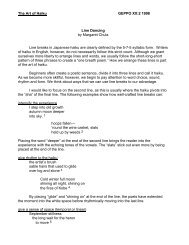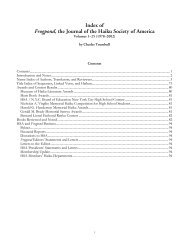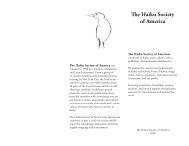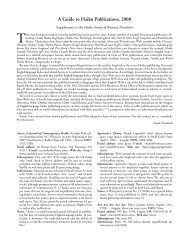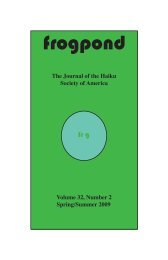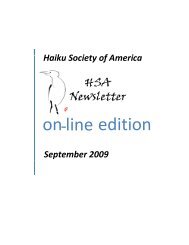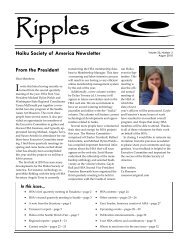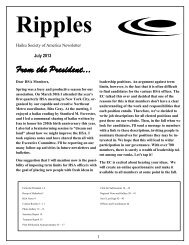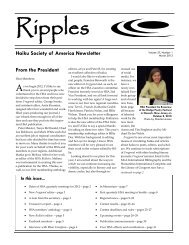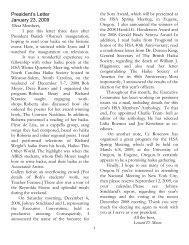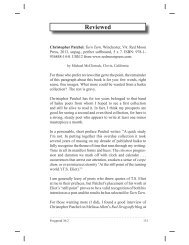Frogpond 34.3 • Autumn 2011 (pdf) - Haiku Society of America
Frogpond 34.3 • Autumn 2011 (pdf) - Haiku Society of America
Frogpond 34.3 • Autumn 2011 (pdf) - Haiku Society of America
Create successful ePaper yourself
Turn your PDF publications into a flip-book with our unique Google optimized e-Paper software.
ather than imposing our own opinions too quickly. So what<br />
do the four lines and an extra line break achieve that the three<br />
lines don’t?<br />
The extra line adds far more than just three words. When I<br />
read the original and then my cropped version aloud, the latter<br />
feels significantly more compressed, and hurries me towards<br />
the juxtaposition <strong>of</strong> the place among the stones and the wagtail.<br />
The addition <strong>of</strong> the opening line, with its pronouncement<br />
<strong>of</strong> “Now,” adds a gravitas to the haiku that’s missing completely<br />
in my three liner. It expands the haiku too, creating a<br />
more balanced and considered division <strong>of</strong> commentary (the<br />
first two lines) and imagery (the last two lines). And <strong>of</strong> course,<br />
“looking back” can be read at different levels too: looking<br />
behind one, literally, but also looking back in time. The three<br />
lines I first suggested might make an acceptable haiku but the<br />
four lines are richer in terms <strong>of</strong> the emotional experience.<br />
10. To suggest balance or imbalance.<br />
Wandering the supermarket aisles<br />
the diagnosis<br />
sinks in 14<br />
Ken Jones uses line break to throw the reader <strong>of</strong>f balance: all<br />
the physical weight <strong>of</strong> the haiku is anchored on the left hand<br />
side while two small words float on their own in the white<br />
space on the right. The form is perfectly suited to the reality <strong>of</strong><br />
the experience, how it takes time for some kinds <strong>of</strong> information<br />
to sink in, how we fill our days with the weight <strong>of</strong> the<br />
ordinary, and how the “truth” <strong>of</strong> a situation can suddenly hit<br />
us and set us adrift.<br />
Two lines can be an appropriate choice for haiku where the<br />
idea <strong>of</strong> balance is important.<br />
in the darkness<br />
pushing open a door 15<br />
Keith J. Coleman’s haiku balances one thing against another:<br />
. . . . . . . . . . . . . . . . . . . . . . . . . . . . . . . . . . . . . . . . . . . . . . . . . . . . . . . . . . . .<br />
78 <strong>Haiku</strong> <strong>Society</strong> <strong>of</strong> <strong>America</strong>



